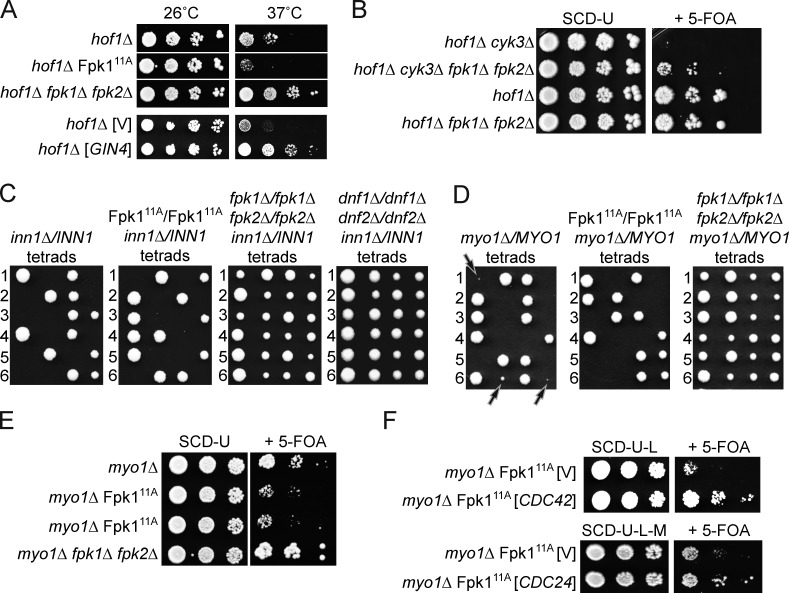Figure 6.
Decreasing flippase function rescues the growth defect of cytokinesis mutants. (A) Cultures of isogenic hof1Δ cells (YFR386), hof1Δ Fpk111A cells (YFR396), and hof1Δ fpk1Δ fpk2Δ (YFR398) cells, each carrying pRS316-HOF1, and hof1Δ cells (YFR386) carrying both an empty vector (YCpLG, V) or the same vector expressing GIN4 (pJT5241) and pRS316-HOF1, were streaked onto plates containing 5-fluoro-orotic acid (5-FOA) medium (Boeke et al., 1984) to select against the presence of the URA3-marked pRS316-HOF1 vector. Colonies arising were streaked on a second set of 5-FOA plates, and the resulting colonies were grown to mid-exponential phase in SCD. Serial 10-fold dilutions were then spotted on SCD plates. After incubation at 26°C or 37°C, as indicated, for 3 d, the plates were photographed. (B) Strains hof1Δ cyk3Δ (YFR422), hof1Δ cyk3Δ fpk1Δ fpk2Δ (YFR425), hof1Δ (YFR387), and hof1Δ fpk1Δ fpk2Δ (YFR424), all carrying pRS316-HOF1, were grown to mid-exponential phase in SCD-U. Serial 10-fold dilutions were spotted on SCD-U plates and plates containing 5-FOA. After incubation at 26°C for 3 d, the plates were photographed. (C) Tetrad analysis of isogenic inn1Δ/INN1 heterozygous diploids that were homozygous for wild-type FPK1 (YFR421), Fpk111A (YFR419), for both fpk1Δ and fpk2Δ (YFR414), or for both dnf1Δ and dnf2Δ (YFR434). (D) Tetrad analysis of isogenic myo1Δ/MYO1 heterozygous diploids that were homozygous for wild-type FPK1 (YFR420) or Fpk111A (YFR412), or for both fpk1Δ and fpk2Δ (YFR413). Arrows indicate microcolonies formed by myo1Δ spores expressing wild-type Fpk1 (left), which are inviable when Fpk111A is present (middle) and, conversely, grow much more robustly when both Fpk1 and Fpk2 are absent (right). (E) The same strains as in D were transformed with pRS316-MYO1 and dissected on SCD-U. The resulting haploid myo1Δ (YFR438), myo1Δ Fpk111A (YFR439; shown in duplicate), and myo1Δ fpk1Δ fpk2Δ (YFR440) strains each carrying pRS316-MYO1 were grown to mid-exponential phase, and serial 10-fold dilutions were spotted on SCD-U plates and plates containing 5-FOA to select against the presence of the pRS316-MYO1 vector. After incubation at 30°C for 3 d, the plates were photographed. (F) A myo1Δ/MYO1 heterozygous diploid that was homozygous for Fpk111A (YFR443) carrying an empty vector (YCpLG, V) or the same vector expressing CDC42 (PB3050), and the same strain carrying an empty vector (pRS315, V) or the same vector expressing CDC24 from the MET25 promoter (pJT4350) were transformed with pRS316-MYO1 and dissected on SCD-U-L (for the CDC42-expressing vector) or SCD-U-L-M (for the CDC24-expressing vector). The resulting myo1Δ Fpk111A strains (YFR448, YFR449, YFR451, and YFR452) were treated as in E.

